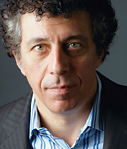Eric Bogosian has flipped the old show biz cliche, “I’m not a doctor but I play one on TV.”
He played a police captain heading a team of investigators on TV’s “Law and Order: Criminal Intent.” But offstage, Bogosian has been deep into researching his book on a group of assassins who sought revenge against the Ottoman Turks deemed responsible for the Armenian genocide.

Bogosian
The actor and author will discuss his research odyssey in the 2013 Berj H. Haidostian Annual Distinguished Lecture. It is at 7 p.m. March 13 in the U-M Museum of Art Helmut Stern Auditorium.
In his talk “Finding Nemesis,” Bogosian will discuss how he originally planned to write a screenplay about the assassination of Talat Pasha, an Ottoman Empire official tied to the 1915-23 Armenian genocide. His focus changed as he learned more of a group called the Nemesis assassins.
“I just thought it was an amazing story. I decided to really do the analysis and research needed to tell the whole story. This process of trying to uncover the truth is real detective work. This has been a real mystery I’ve had to unravel,” he says.
Over five years, Bogosian, who is of Armenian descent, has interviewed prominent historians around the world and translated primary texts from Armenian, French and German. He also conducted primary research in the British archives, and threw himself into a crash course on Armenian and Turkish history.
Bogosian says it was long thought that Soghomon Tehlirian acted alone in killing Talat in Berlin in 1921. But by the 1960s, historians were saying evidence more clearly pointed to a larger Armenian group known as the Nemesis assassins, which included Tehlirian. Bogosian says the group, operating out of Watertown, Mass., was dedicated to revenge against Ottoman and Turkish officials believed responsible for the genocide of an estimated 1 million.
“They stalked and killed about a dozen people,” he says. “When you talk about organized groups that operate out of one country and kill leaders of other countries, it becomes more of a hot topic because it’s not supposed to be done.”
Bogosian says the men viewed themselves as holy warriors. They successfully gained donations for their cause from the Armenian diaspora around the world and in the United States. “They were very smart. They basically launched themselves into places where they knew there were Turks and then they watched them. Assassination had developed into an art, because of the technology of making bombs and pistols,” he says.
He says one of the most striking things he learned in his research was that the British two weeks before Talat was killed had sent an agent to Germany, to speak with him. “The British didn’t like what they heard. He was threatening Britain with Islamic revolution in some of the lands they held, and interestingly within two weeks of the time the British agent interviewed him, Talat was dead,” Bogosian says.
The lecture is sponsored by the Armenian Studies Program, Arts at Michigan, the Department of Screen Arts & Cultures, and the University Musical Society.

